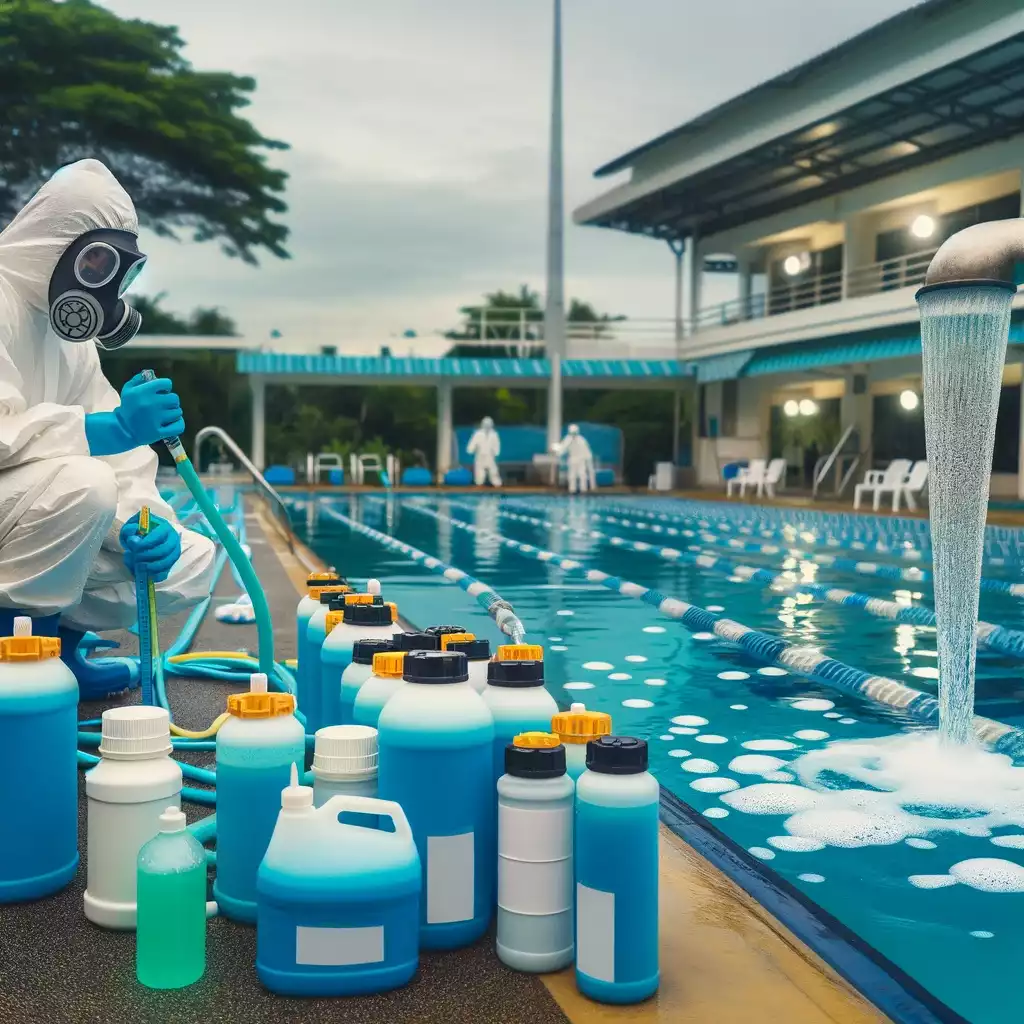The water quality in swimming pools directly affects the health and comfort of users. Therefore, it is crucial to understand and master the methods of daily swimming pool sewage treatment. In this article, we’ll explore several effective pool wastewater treatment methods that not only keep your water clear but also keep your pool sanitary and safe. Whether it’s a home pool or a public pool, these methods will provide you with valuable reference.
In order to ensure the cleanliness and safety of swimming pools, water treatment is an important link. Here are detailed methods for water treatment

Ⅰ、Pool Water Purification
First, the water in the swimming pool is effectively flocculated and settled. This flocculant can gather impurities and dirt in sewage together and settle them to the bottom of the pool. Doing so can help remove suspended solids from the water and increase the transparency of the water.
Ⅱ、Suction of Dirt
Initially, you have to wait for a period of time, allowing the flocculant to stay in the swimming pool for 1-2 hours to ensure the effectiveness of the drug. During this period, the flocculant gathers small particles and impurities together to form large blocks, which gradually settle to the bottom of the pool.
After the agent has fully exerted its effect, use a special suction device to clean the bottom of the pool. The mud suction device uses strong suction to suck the sediment at the bottom into the machine and store it in a fixed collection box. This step is very critical for removing dirt and grime from the pool, as they not only reduce the clarity of the pool water but also provide a breeding ground for bacteria and algae.
When operating the suction machine, ensure it covers the entire bottom of the pool evenly, making sure no area is missed. For corners and hard-to-reach areas of the pool floor, you may need to use hand tools to assist with cleaning.
Ⅲ、Pool Water Disinfection
1、Choose the right disinfectant:
After cleaning, choose a disinfectant specifically for the pool, such as trichlor or odorless chlorine granules. It is highly effective for sterilization, disinfection, purification, and other functions to ensure the hygiene of swimming pool water.
2、Add disinfectant correctly:
According to the size of the pool and the amount of water, accurately add the recommended dosage on the disinfectant instructions. Disinfectant should be dispersed evenly throughout the pool to ensure that the entire pool water is effectively disinfected.
3、Regularly test the chlorine content in the water:
During the disinfection process, you need to regularly use a water test box to test the chlorine content in the swimming pool water. It is crucial to keep the concentration of chlorine in the water within the normal range of 0.3 to 1.0. This concentration range is sufficient to kill most bacteria and viruses without posing a health hazard to pool users.
4、Adjust the amount of disinfectant as needed:
If the test results show that the chlorine content in the water is less than 0.3, disinfectant should be added immediately to reach the appropriate level; if the chlorine content is higher than 1.0, there is no need to add disinfectant temporarily. For swimming pools that are closed, you can increase the amount of disinfectant after closing, and add an appropriate amount according to the test results of the chlorine content in the water at noon the next day until the chlorine content stabilizes between 0.3 and 1.0.
Ⅳ、Algae Removal from Pool Water
When algae appear in the water, algaecide can be used for treatment, usually once every half month. When using algaecides, be careful not to use them simultaneously with disinfectants to avoid chemical reactions.
Ⅴ、Impact Treatment
Over time, the bacteria in the swimming pool water will gradually become resistant to traditional disinfection methods, resulting in a decrease in disinfection effectiveness. The impact method is to drop a large amount of disinfectant at one time, which can effectively break bacterial resistance and keep the water body clean and safe.
Specific operation method: Perform impact treatment on the swimming pool water every half month. The specific operation is to instantly put 7 to 8 grams of trichlor per ton of water. Taking a swimming pool with a capacity of 2,500 cubic meters as an example, this means that approximately 20 kilograms of trichlor need to be added to the entire swimming pool. This dose can be adjusted appropriately according to the actual water volume and water quality of the swimming pool.
Note: When performing impact treatments, make sure no one is in the pool. Since the amount of disinfectant injected at one time is large, you should wait for a period of time after treatment until the chlorine concentration in the water drops back to a safe range before allowing swimmers to enter. In addition, water quality should be re-tested after treatment to ensure that the chemical composition of the water meets safety standards.
Follow-up: After shock treatment, water quality should be continuously monitored to ensure that the pool water returns to the ideal chemical balance. If necessary, the amount of regular disinfectant can be adjusted appropriately in subsequent days.
In short, daily cleaning and sewage treatment of swimming pools are key to ensuring water quality safety and improving user experience. Through the various methods introduced above, not only can pollutants be effectively removed, but the swimming pool water can also be kept clean and hygienic. Remember, regular pool maintenance and inspections are important measures to ensure your pool remains in good condition over the long term.
